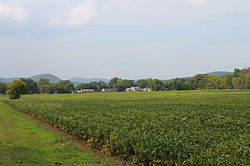Wolf Township, Lycoming County, Pennsylvania
| Wolf Township, Lycoming County, Pennsylvania |
|
|---|---|
| Township | |

Field in Wolf Township
|
|
 Map of Lycoming County, Pennsylvania highlighting Wolf Township |
|
 Map of Lycoming County, Pennsylvania |
|
| Coordinates: 41°15′2″N 76°43′4″W / 41.25056°N 76.71778°WCoordinates: 41°15′2″N 76°43′4″W / 41.25056°N 76.71778°W | |
| Country | United States |
| State | Pennsylvania |
| County | Lycoming |
| Settled | 1777 |
| Incorporated | 1824 |
| Area | |
| • Total | 19.6 sq mi (50.7 km2) |
| • Land | 19.6 sq mi (50.7 km2) |
| • Water | 0.0 sq mi (0.0 km2) |
| Elevation | 558 ft (170 m) |
| Population (2000) | |
| • Total | 2,707 |
| • Density | 138.3/sq mi (53.4/km2) |
| Time zone | Eastern (EST) (UTC-5) |
| • Summer (DST) | EDT (UTC-4) |
| FIPS code | 42-85984 |
| GNIS feature ID | 1216777 |
Wolf Township is a township in Lycoming County, Pennsylvania, United States. The population was 2,707 at the 2000 census. It is part of the Williamsport, Pennsylvania Metropolitan Statistical Area.
Wolf Township was formed from part of Muncy Township by the Pennsylvania General Assembly in September 1834. The township is named for George Wolf who was the governor of Pennsylvania from 1829 to 1835. The boroughs of Hughesville and Picture Rocks are on land that was taken from Wolf Township.
Wolf Township today has grown to a population of 2,707 residents as of the 2000 census. This is up from 734 residents at the census of 1890.
The geology of Wolf Township played a role in its history. Limestone was quarried west of Hughesville for use as lime. Lime is used in large quantities as building and engineering materials (including limestone products, concrete and mortar) and as chemical feedstocks, among other uses. Lime industries and the use of many of the resulting products date from prehistoric periods in both the Old World and the New World. Wolf Township was also the home to several Pennsylvania Bluestone quarries. Pennsylvania Bluestone has many uses, from cut dimensional stone used in patios, walkways and stair treads to architectural stone used in buildings. It is also used for wallstone, decorative boulders, natural steps and other landscape features. The name "Pennsylvania Bluestone" is due to its predominantly blue color and because the majority of stone is quarried in Pennsylvania.
...
Wikipedia
